Hemigrapsus nudus (Dana, 1851)Common name(s): Purple shore crab, Naked shore crab |
|
| Synonyms:
Pseudograpsus nudus Heterograpsus nudus Brachynotus nudus |
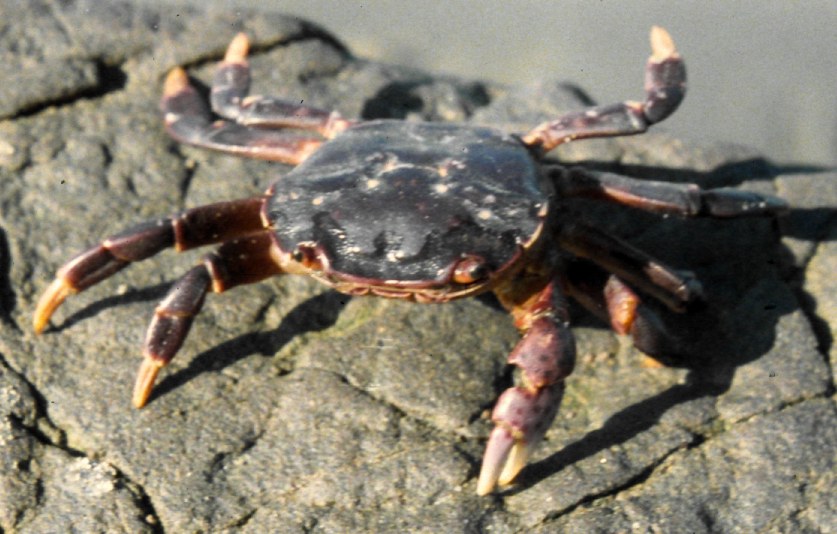 |
| Phylum Arthropoda
Subphylum Crustacea Class Malacostraca Subclass Eumalacostraca Superorder Eucarida Order Decapoda Suborder Pleocyemata Infraorder Brachyura (true crabs) Section Brachyrhyncha Family Varunidae |
|
| Hemigrapsus nudus, San Simeon, CA. About 4 cm carapace width. | |
| (Photo by: Dave Cowles, May 1995) | |
How to Distinguish from Similar Species: Hemigrapsus oregonensis also has 3 anterolateral teeth but no purple spots on the chelipeds and the legs have abundant setae. Pachygrapsus crassipes (Oregon and south) has transverse lines and 2 anterolateral teeth on the carapace.
Larvae in the first zoeal stage can be distinguished from zoea of H. oregonensis because H. oregonensis has lateral projections on only abdominal segment 2 while H. nudus has lateral projections on abdominal segments 2 and 3 (Lee and Ko, 2008).
Geographical Range: Yakobi Island, Alaska to Bahia de Tortuga, Mexico. Uncommon below central CA.
Depth Range: Mostly intertidal
Habitat: Under rocks and in cracks. Also high in some estuaries.
Biology/Natural History: Does not live in burrows, as Hemigrapsus oregonensis often does. The chela of males, as of H. oregonensis and P. crassipes, have a prominent tuft of hairlike setae on the palm. This species is an osmoregulator and can tolerate both hypo- and hyperosmotic conditions. In Puget Sound feeds on diatoms, desmids, and small Ulva and Enteromorpha green algae scraped from rocks with the tips of the chelae. May also feed on a few animal products, such as amphipods and the eggs of Nucella emarginata and other whelks. In Puget Sound, females carrying eggs are found from January to mid-July; especially in April. Female may carry from 400 to 36,000 eggs. This species sometimes has the pasasitic isopod Portunion conformis in the perivisceral cavity, and the eggs may be attacked by the tiny Nemertean worm Carcinonemertes epialti. Predators include gulls white-winged scoters, Anthopleura anemones, and staghorn and tidepool sculpins. Nucella lamellosa seems to be attracted to the scent of this crab but is not known to be a predator.
A related member of this genus, Hemigrapsus sanguineus, that lives in Japan is host to the sacculinid barnacle Sacculina yatsui (Kobayashi et al., 2018. Journal of Crustacean Biology 38:3 pp 329-340. doi 10.1093/jcbiol/ruy020)
While the large majority and abundant species of true (Brachyuran) crabs such as Hemigrapsus walk sideways, members of a few true crabs and crab relatives such as most Anomurans walk forward. In a 2025 preprint, Taniguchi et al. speculate that the sideways walking in so many true crab species is is because walking sideways allows for rapid escape locomotion options in two directions, providing a selective advantage.
| Return to: | |||
| Main Page | Alphabetic Index | Systematic Index | Glossary |
References:
Dichotomous Keys:Coffin, 1952
Flora and Fairbanks, 1996
Hart, 1982
Kozloff 1987, 1996
Smith and Carlton, 1975
Wicksten, 2009
General References:
Jensen,
1995
Kozloff,
1993
Morris
et al., 1980
Niesen,
1994
O'Clair
and O'Clair, 1998
Scientific Articles:
Burnett, Nicole, 2024: A practical identification guide to the zoeae of the invasive European green crab, Carcinus maenas (Linnaeus, 1758) (Decapoda: Brachyura: Carcinidae), and to the zoeae of the families of brachyuran crabs in Washington state, USA. Journal of Crustacean Biology 44:4. doi.org/10.1093/jcbiol/ruae064
Lee,
Seok Hyun and Hyun Sook Ko, 2008. First zoeal
stages of six species
of Hemigrapsus
(Decapoda:
Brachyura: Grapsidae) from the northern Pacific including an
identification
key. Journal of Crustacean Biology 28:4 pp. 675-685
While the large majority and abundant species of true (Brachyuran)
crabs walk sideways, members of genus Hyas walk forward. In a 2025 preprint, Taniguchi et al.
speculate that the sideways walking in so many true crab species is is
because walking sideways allows for rapid escape locomotion options in
two directions, providing a selective advantage.
General Notes and Observations: Locations, abundances, unusual behaviors:
This species seems to be less tolerant of hypoxia than is is H. oregonensis. In places where their range overlap it is usually found higher in the intertidal and on more sandy/less muddy substrate.
A related species, H. sanguineus (Asian shore crab) on the New England coast was shown to prefer animal prey such as small mussels and barnacles, even though it could also feed on algae. When starved or in crowded conditions it ate algae, but if given a free choice it chose invertebrates. The authors speculated that the species may have an important effect on competition and succession among intertidal attached species. Source: Brousseau, Diane J. and Jenna A. Baglivo, 2005. Laboratory investigations of food selection by the asian shore crab, Hemigrapsus sanguineus: algal versus animal preference. J. Crust. Biol. 25(1): 130-134 (abstract)
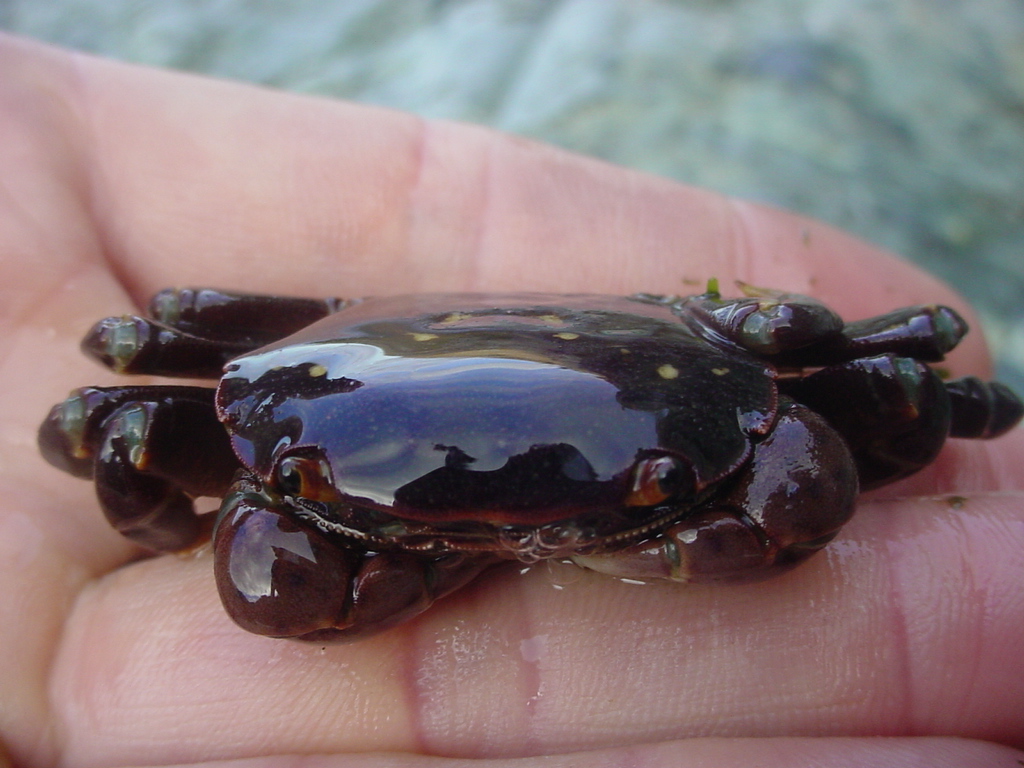
This individual is from Sares Head. Photo by Dave Cowles,
Sept
2005
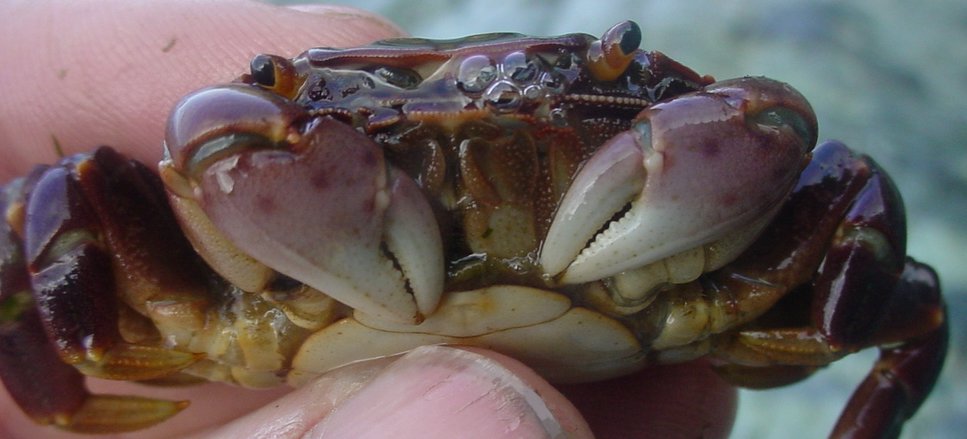
Notice that the purple spots on the chelae are less distinct on this
individual than on some. Photo by Dave Cowles, Sept 2005
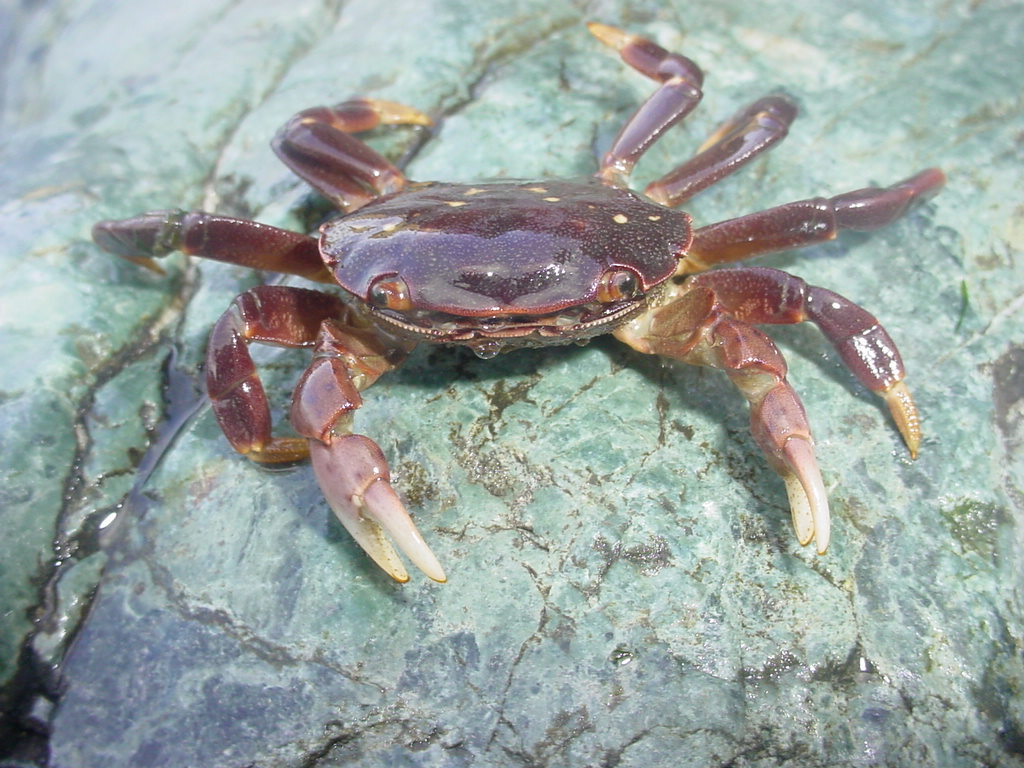
Many crabs "slobber" bubbles when out of water because they are pumping
air and water in their gill chambers, whose outlets are near the
mouth.
Photo by Dave Cowles, Sept 2005
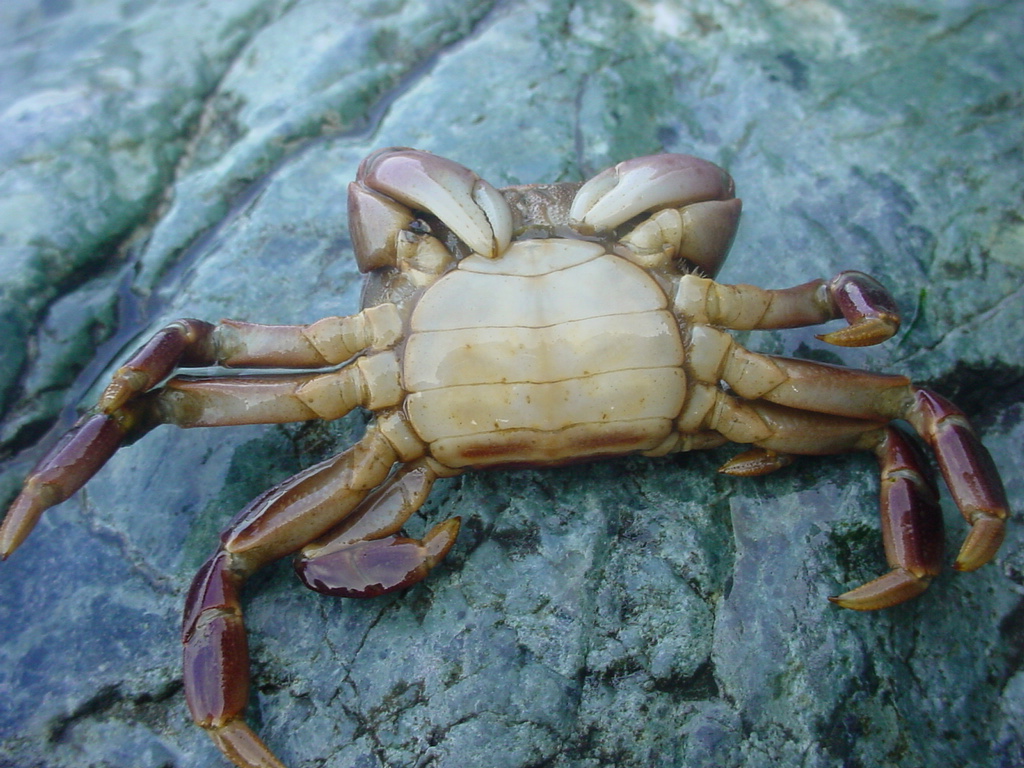 |
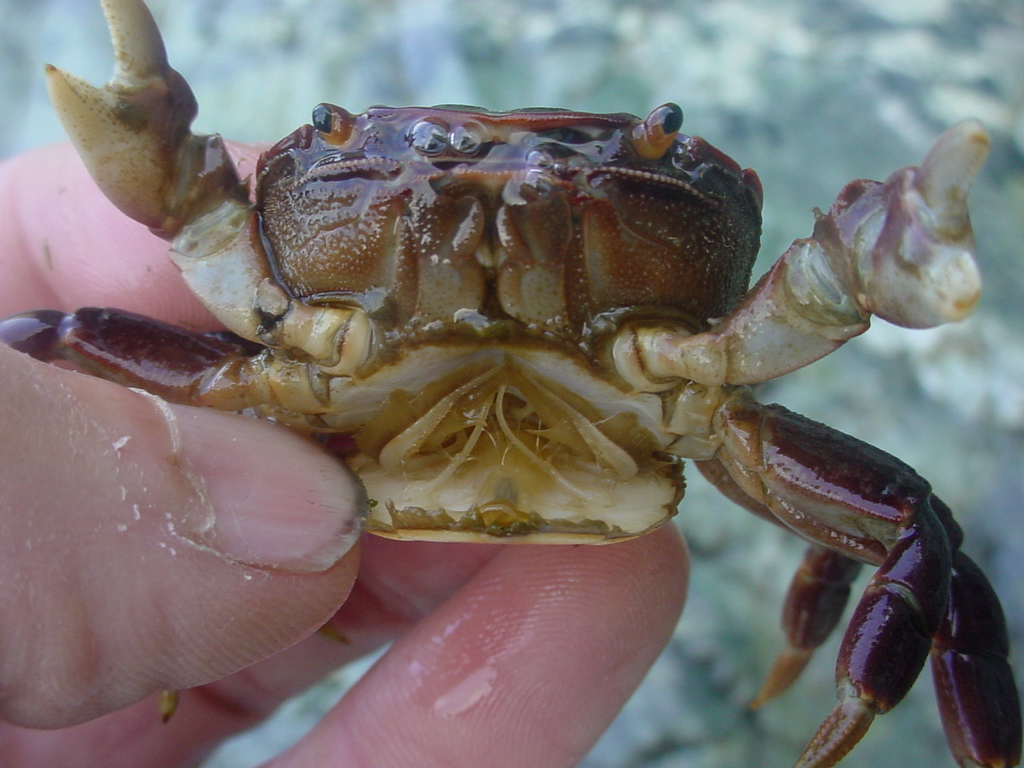 |
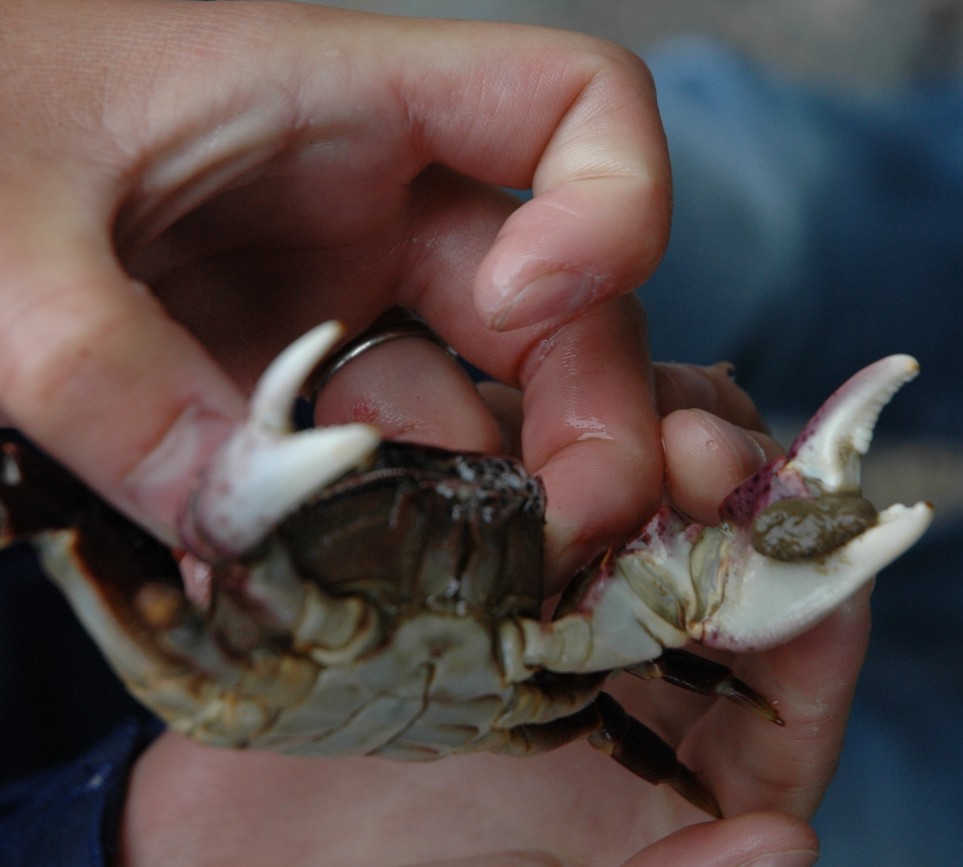
Males of this species have a tuft of fine setae
on the inner palm of their chelae,
as seen here. Note also the much narrower abdomen than is
seen in
the female.
Photo by Dave Cowles, July 2006
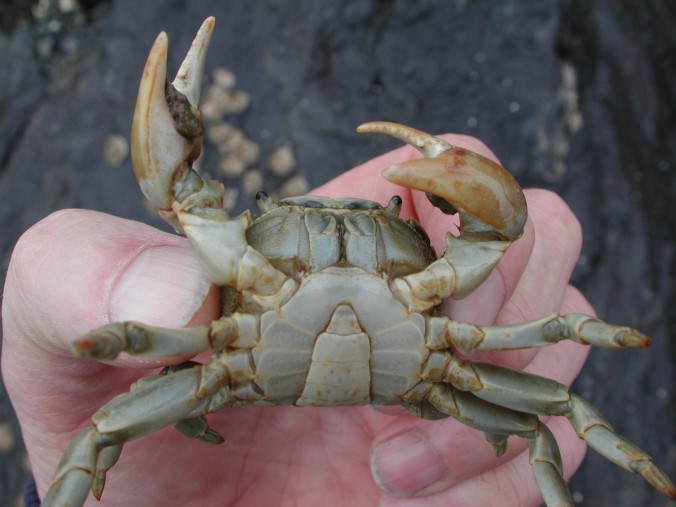
This male also shows the narrow abdomen and the tufts of setae
on the chelae.
Photo by Dave Cowles, July 2009
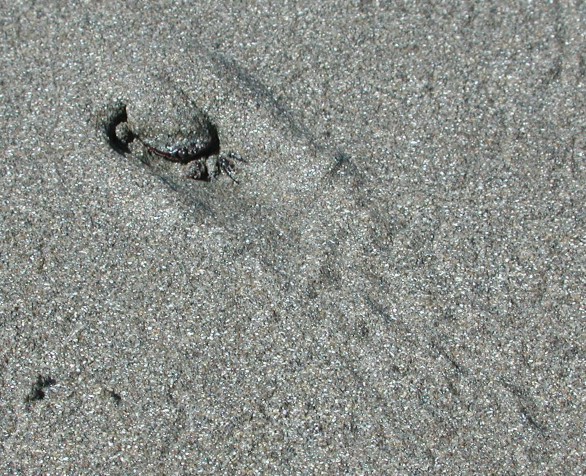
In an August 2007 trip to Shi Shi beach we found that Hemigrapsus
nudus range over flat sandy beach areas, leaving a long set
of crab
tracks behind. Several seemed to have gotten stranded by the
retreating
tide and buried themselves at the end of their tracks far above the
water
line at low tide, like this individual. Many gulls were
present on
the beach so burying doubtless contributes to the crabs' survival.
Authors and Editors of Page:
Dave Cowles (2005): Created original page